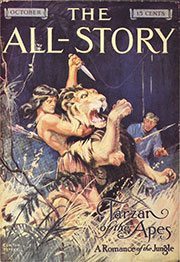 by Vicki Palmquist
by Vicki Palmquist
In its October 1912 issue, All-Story Magazine published a short story by Edgar Rice Burroughs called “Tarzan of the Apes.” Do you remember the plot? John Clayton is born to parents who are marooned on the west coast of Africa. His parents, Lord and Lady Greystoke, die on his first birthday. John is adopted by Kala, an ape, who mothers him as one of her own. He is that child who is unaware he is human. He goes on to be a man more comfortable in the jungle than he is among the gentry, his birthright. He grows up and marries Jane Porter but he returns to his loincloth-and-knife existence as often as he can.
For many years, Tarzan of the Apes with its nearly flawless male hero was one of the books constantly named as a favorite among teen readers. Reading the book, one could imagine oneself living outside of society and any imposed restrictions and expectations. The jungle seemed like a hospitable place which, although very dangerous, offered opportunities to prove the mettle of your existence.
These books can be viewed through a nostalgic, historical lens as being written at a time when Burroughs, proud of his Anglo-Saxon heritage, wrote with the colonial viewpoint of white English supremacy. Today’s readers will find his attitude dated, if not repugnant, and yet the Tarzan books are a part of our growing-up as readers and their influence on an entire genre of fiction continues to be acknowledged.
JANE GOODALL
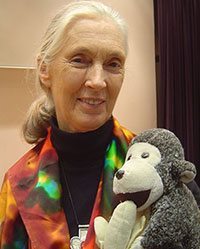 Tarzan of the Apes does, indeed, have a tie-in with our Bookstorm™ this month, Untamed: the Wild Life of Jane Goodall by Anita Silvey (National Geographic).
Tarzan of the Apes does, indeed, have a tie-in with our Bookstorm™ this month, Untamed: the Wild Life of Jane Goodall by Anita Silvey (National Geographic).
In a 2012 interview on Big Issue, Dr. Goodall wrote: “I read the Tarzan books and of course I fell completely in love with Tarzan. I felt he’d married the wrong Jane — it should have been me. I was very jealous of Jane. My mum saved up to take me to see a Tarzan film at the cinema but a few minutes in I got very upset and had to be taken out. I said: ‘That wasn’t Tarzan.’ Johnny Weissmuller was not how I imagined Tarzan at all. And to this day I’ve never ever watched another Tarzan film.” (Photo: Dr. Jane Goodall, taken by jeekc in 2007, Creative Commons license.)
FERAL CHILDREN
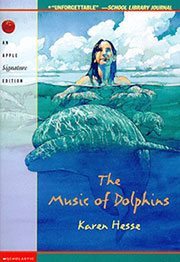 In literature and in science, children who are lost or abandoned in the wild are called “feral children.” There are a number of stories and books, offering evidence of our fascination with this concept.
In literature and in science, children who are lost or abandoned in the wild are called “feral children.” There are a number of stories and books, offering evidence of our fascination with this concept.
Gilgamesh, Romulus and Remus, and Pecos Bill are classically represented as children raised by animals.
You may have read the following books or you’re adding them to your TBR pile now.
- Mila in Music of the Dolphins by Karen Hesse
- Peter Pan by J.M. Barrie
- Mowgli in The Jungle Book by Rudyard Kipling
- The Blue Lagoon by Scott O’Dell
- Valentine Michael Smith in Robert Heinlein’s Stranger in a Strange Land was raised by Martians. This is not precisely fitting with the definition of feral children but, having never met a Martian, I’m not sure.
- Even Gilligan’s Island had an episode with a “jungle boy,” played by Kurt Russell
Here’s an article about “Feral Children: Mind Blowing Cases of Children Raised by Animals,” written by Mihai Andrei for ZME Science.
EDGAR RICE BURROUGHS
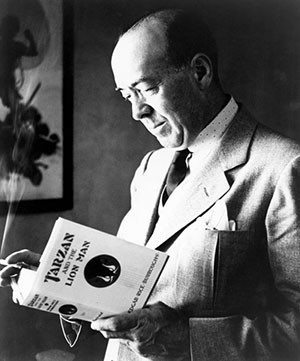 Married, with two children, Burroughs tried his hand at many endeavors and didn’t succeed at any of them. The pressures to provide a living for his family spurred him on to submit a story he wrote for publication.
Married, with two children, Burroughs tried his hand at many endeavors and didn’t succeed at any of them. The pressures to provide a living for his family spurred him on to submit a story he wrote for publication.
Edgar Rice Burroughs’ first published story was “Under the Moons of Mars,” featuring John Carter, which appeared in All-Story Magazine in 1912. It earned him $400. He’s credited with “helping to lead pulps into their golden era of publishing.”
He sold Tarzan of the Apes to the Prank A. Munsey company for $700, which is $17,164 in today’s money. He had a hard time finding a book publisher, but once A.C. McClurg and Company published Tarzan, it became a 1914 bestseller.
Edgar Rice Burroughs himself wrote, “In all these years I have not learned one single rule for writing fiction. I still write as I did 30 years ago; stories which I feel would entertain me and give me mental relaxation, knowing that there are millions of people just like me who will like the same things I like. Anyway, I have great fun with my imaginings, and I can appreciate – in a small way – the swell time God had in creating the Universe.”
Here is Chapter One of John Taliaferro’s biography, Tarzan Forever, The Life of Edgar Rice Burroughs, Creator of Tarzan.
JUST THOUGHT YOU’D LIKE TO KNOW
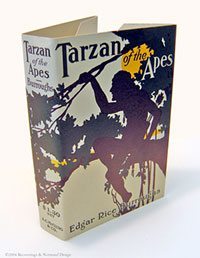 Did you know that the town of Tarzana, California is located on Edgar Rice Burroughs’ former 550-acre ranch, which was named, not surprisingly, Tarzana Ranch?
Did you know that the town of Tarzana, California is located on Edgar Rice Burroughs’ former 550-acre ranch, which was named, not surprisingly, Tarzana Ranch?
Burroughs had another wildly successful book series beyond Tarzan, set at the Earth’s core! Known as Pellucidar, there are seven books, which also have a fervent following. In one of the books, Tarzan finds his way to Pellucidar, Tarzan at the Earth’s Core.
The original dust jacket was hard to come by for collectors. In 2014, Phil Normand of Recoverings.com recreated that original dust jacket and sold it to collectors for $50.
Are you a fan of the Tarzan books? Leave a comment to let us know why they appeal to you.
